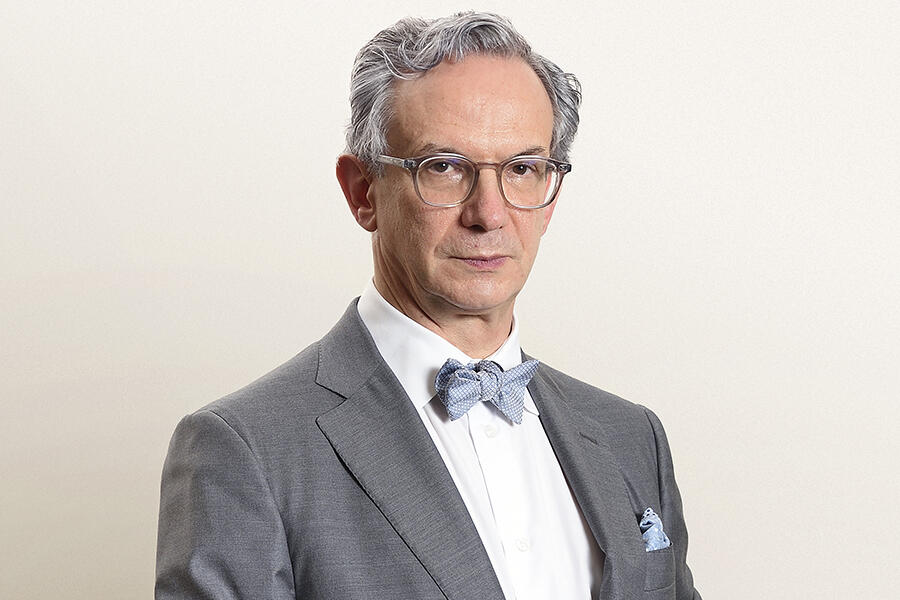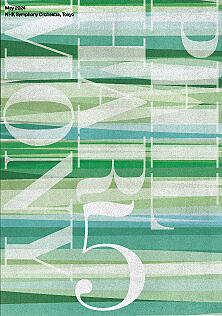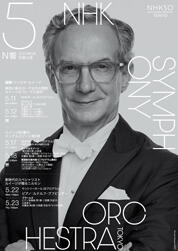- Home
- Concerts
- Subscription Concerts 2023-2024
- Program A
- No. 2010 Subscription (Program A)
Subscription Concerts 2023-2024Program A
No. 2010 Subscription (Program A)
NHK Hall
Google Map Seating Chart

Program
Panfili / Abitare la battaglia [Japan Premiere]
Riccardo Panfili (1979–), one of the most sought-after Italian contemporary composers, dedicated his Abitare la battaglia (Living the Battle) “with affection, esteem and gratitude” to the conductor Fabio Luisi who world-premiered both the original version (2017) and the substantially-revised version (2022). Back in 2016, Panfili’s Oltre la linea for orchestra, commissioned by Milan’s Teatro alla Scala, had been revealed by Luisi on the podium.
Born in Terni, Panfili held the spotlight in 2006 when his Danzario won the Santa Cecilia International Composition Competition to be first performed under Antonio Pappano’s baton. Four years later, Panfili was chosen as musical assistant to the foremost composer Hans Werner Henze (1926–2012). Panfili’s latest opera Noi, due, Quattro… (2019) was commissioned by Florence’s Teatro del Maggio Musicale of which Luisi served as music director from 2018 to 2019.
Abitare la battaglia, another commission from Maggio Musicale, was composed for their New Year’s Eve concert conducted by Luisi to be programmed alongside Beethoven’s philanthropic Symphony No. 9. Panfili named this short but intense piece after Gabriele Baldini’s study of Verdi’s operas*. According to Panfili, the term “battle” has linked Verdi and Beethoven in his mind due to their fight for society but also their tireless combat in musical creation against routine and mannerism. Opening Misterioso (mysteriously) in the lowest volume (ppppp), Abitare la battaglia reaches its zenith at the central Selvaggio (savage) section. The tranquil close comes right after the inexorable Apocalittico (apocalyptic) section with heavy blows from timpani.
* The full title is Abitare la Battaglia. La Storia di Giuseppe Verdi (Living the Battle – The Story of Giuseppe Verdi)
[Kumiko Nishi]
Respighi / Pini di Roma, symphonic poem (Pines of Rome)
The cradle of opera, sonata and sinfonia, Italy had always played the lead role in every sphere of classical music history. In the course of the 19th century, however, Austro-German composers came into the mainstream of instrumental music, while Italy witnessed the phenomenal development of opera led by Rossini (1792–1868) and Verdi (1813–1901). The early 20th century saw the revival of instrumental creation in the Italian Peninsula, to which Respighi’s contributions cannot be overestimated.
Originally from Bologna, Ottorino Respighi (1879–1936) is known for his elaborate scoring skills. These were honed under Rimsky-Korsakov (1844–1908), a greatest orchestrator, while the young Italian was working as a viola player in Saint Petersburg. The “Roman Trilogy” performed today represents Respighi’s colorfully imaginative orchestration. It was penned after he moved to Rome in 1913 as the city’s beauty, history and flourishing orchestral concert culture inspired him. Each of the three pieces has four parts played without pause, with the detailed programmatic explanations by the composer himself on the scores.
The second of the triptych, Pini di Roma (1923–1924) pays tribute to centuries-old pine trees, a symbol of immortality and vitality, which have graced the Eternal City’s scenery since ancient times. The animated first part depicts children at play around pines in the Villa Borghese gardens built in the 17th century, while the mysteriously gloomy second part evokes pines by the entrance of an ancient catacomb, subterranean burial for early Christians. The slow third part pictures moonlit pines on the Janiculum Hill: towards the end of the score, Respighi requests to utilize a recording of a singing nightingale (replaced by a bird whistles for today's performance) over the violins’ trills, which made him one of the earliest composers who included pre-recorded sounds in acoustic orchestration. The finale, in march rhythm and tempo, praises the Appian Way lined with pine trees. A quiet misty daybreak is followed by an extended crescendo suggesting the approach of a legion marching on this military road built in 312 BC. Trumpets resound: with the rising Sun in the background, victorious soldiers mount to the Capitoline Hill.
[Kumiko Nishi]
Respighi / Fontane di Roma, symphonic poem (Fountains of Rome)
Ottorino Respighi (1879–1936) wrote Fontane di Roma in 1915–1916 as a lone piece. When the 1917 premiere got a cool reception, producing the sequels was still not to be thought of. Only its successful 1918 performance under Arturo Toscanini’s baton to a great sensation led to Respighi’s world-wide fame as the composer of the Trilogy to come.
Fontane presents four of Rome’s fountains at the hours when each one’s beauty appears the most impressive to us. The idyllic first part describes a fountain in the Valle Giulia area at dawn. The next part, on a bright morning, pictures the 17th-century Triton Fountain sculpted by the Baroque master Gian Lorenzo Bernini. The powerful French horns imitate the summons of the sea god Triton blowing his conch shell. Opening with a solemn tune, the third part captures the magnificence of the famous 18th-century Trevi Fountain, Rome’s largest fountain, at midday. The finale is flooded with nostalgia: it’s dusk at the Villa Medici Fountain. Singing birds, rustling leaves in the gentle breeze, tolling bells are heard, then everything fades into the still of the night.
[Kumiko Nishi]
Respighi / Feste Romane, symphonic poem (Roman Festivals)
In the triptych, Feste Romane (1928) calls for the largest orchestra including a varied percussion section, piano, organ, mandolin and buccinas (buccina is a brass signal instrument used in the ancient Roman military and replaced by trumpets during today’s performance following the suggestion by the composer). Ottorino Respighi (1879–1936) ’s graphic tone painting lets us come down in time to look on four different Roman event/celebrations.
The setting of the opening scene is an ancient Roman stadium. A fanfare resounds for a cruel circus, the audience shouts, and hungry beasts growl. About to be their prey, Christian martyrs chant a sorrowful melody. The second part invites us to the medieval era, when Christian pilgrims get to Rome to celebrate the Jubilee. The third part illustrates the Renaissance wine-grape harvest festival in the Castelli Romani hills with a mandolin, hardly seen in the classical orchestra, playing a serenade. The finale is set in the Piazza Navona square on a modern night before Epiphany. Opened by vibrant clarinet tunes, the merry music portrays a saltarello (an Italian fast folk dance in triple-meter), a barrel organ, bacchanalian revelers and the like to end the Trilogy euphorically.
[Kumiko Nishi]
*Program order of the concert has changed from initially announced.
Artists
 ConductorFabio Luisi
ConductorFabio Luisi
Fabio Luisi hails from Genoa. He is the Principal Conductor of the Danish National Symphony Orchestra and the Music Director of the Dallas Symphony Orchestra. He first conducted the NHK Symphony Orchestra in 2001, and in September 2022 he became Chief Conductor of the orchestra. He conducted Verdi’s Requiem in the concert to celebrate his appointment, and Mahler’s Symphonie der Tausend to commemorate the orchestra’s 2000th subscription concert in December 2023. These two monumental performances have brought him great success. He has presented works of German and Austrian composers such as Beethoven, Brahms, Bruckner and R. Strauss as well as those of Franck and Saint-Saëns, Francophone composers, and with his conducting style full of passion and poetic sentiment, has captured the hearts of many of audience members. In August 2023, his tenure as Chief Conductor was extended by three years until August 2028.
He was General Music Director of the Opernhaus Zürich, Principal Conductor of the Metropolitan Opera in New York, Principal Conductor of the Wiener Symphoniker, as well as General Music Director of the Staatskapelle Dresden and the Sächsische Staatsoper, Artistic Director and Principal Conductor of the MDR Sinfonieorchester Leipzig, Music Director of the Orchestre de la Suisse Romande and Chief Conductor of the Tonkünstler Orchester. He is Music Director of the Festival della Valle d’Itria in Martina Franca (Apulia) and has appeared as guest conductor with numerous renowned ensembles, including the Philadelphia Orchestra, the Cleveland Orchestra, the Münchener Philharmoniker, the Filarmonica della Scala, the London Symphony Orchestra, the Royal Concertgebouw Orchestra, and the Saito Kinen Orchestra, while also conducting operas at world’s major opera houses. Important recordings include Verdi, Bellini, Schumann, Berlioz, Rachmaninov, Rimsky-Korsakov, Frank Martin, and Franz Schmidt, the largely forgotten Austrian composer. In addition, he has recorded various symphonic poems by Richard Strauss, and a lauded reading of Bruckner’s Symphony No. 9 with the Staatskapelle Dresden. His recordings of Wagner’s Siegfried and Götterdämmerung with the Metropolitan Opera won Grammy awards.
Download
Ticket
Program A
No. 2010 Subscription (Program A)
NHK Hall
Google Map
Seating Chart
Single Tickets Release Date
Pre-sales for Subscribers:Wednesday, February 28, 2024
*about subscribers
Sale to General Public:Sunday, March 3, 2024
Price
| S | A | B | C | D | E | |
|---|---|---|---|---|---|---|
| Ordinary Ticket | 9,800 | 8,400 | 6,700 | 5,400 | 4,400 | 2,800 |
| Youth Ticket | 4,500 | 4,000 | 3,300 | 2,500 | 1,800 | 1,400 |
Seating chart Enlarge Print PDF
*tax included
*Subscribers receive a 10% discount (Available at NHKSO WEB Ticket and N-Kyo Guide)
*For wheelchair-accessible seats, please refer to the N-Kyo Guide
Youth Tickets
Youth Tickets are great options for those of 25 years old and younger
Subscription tickets
Release Date
ANNUAL SUBSCRIPTION TICKETS
Mon., July 17, 2023 10:00am
[For Subscribers: Sun., July 9, 2023 10:00am]
SEASONAL SUBSCRIPTION TICKETS (SPRING)
Fri., February 16, 2024 10:00am
[For Subscribers: Wed., February 7, 2024 10:00am]
For further information and
subscription application
Other Ticket Agents
Broadcast
 NHK-FMNo. 2010 Subscription (Program A)
NHK-FMNo. 2010 Subscription (Program A)
Thursday, May 16, 2024 7:30PM - 9:10PM
Program:
Panfili / Abitare la battaglia [Japan Premiere]
Respighi / Pini di Roma, symphonic poem (Pines of Rome)
Respighi / Fontane di Roma, symphonic poem (Fountains of Rome)
Respighi / Feste Romane, symphonic poem (Roman Festivals)
*Program order of the concert has changed from initially announced.
Conductor:Fabio Luisi
Recorded:May 11, 2024 NHK Hall
*Repertoire, conductor, soloists and program order are subject to change without notice.
*Pre-school children are not allowed in the concert hall



